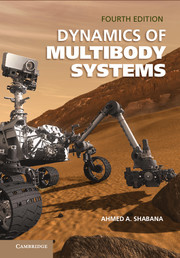Book contents
- Frontmatter
- Dedication
- Contents
- PREFACE
- 1 INTRODUCTION
- 2 REFERENCE KINEMATICS
- 3 ANALYTICAL TECHNIQUES
- 4 MECHANICS OF DEFORMABLE BODIES
- 5 FLOATING FRAME OF REFERENCE FORMULATION
- 6 FINITE-ELEMENT FORMULATION
- 7 THE LARGE DEFORMATION PROBLEM
- 8 CONCEPTS AND ESSENTIAL DETAILS
- APPENDIX: LINEAR ALGEBRA
- References
- Index
4 - MECHANICS OF DEFORMABLE BODIES
Published online by Cambridge University Press: 05 June 2014
- Frontmatter
- Dedication
- Contents
- PREFACE
- 1 INTRODUCTION
- 2 REFERENCE KINEMATICS
- 3 ANALYTICAL TECHNIQUES
- 4 MECHANICS OF DEFORMABLE BODIES
- 5 FLOATING FRAME OF REFERENCE FORMULATION
- 6 FINITE-ELEMENT FORMULATION
- 7 THE LARGE DEFORMATION PROBLEM
- 8 CONCEPTS AND ESSENTIAL DETAILS
- APPENDIX: LINEAR ALGEBRA
- References
- Index
Summary
Thus far, only the dynamics of multibody systems consisting of interconnected rigid bodies has been discussed. In Chapter 2, methods for the kinematic analysis of the rigid frames of reference were presented and many useful kinematic relationships and identities were developed. These kinematic equations were used in Chapter 3 to develop general formulations for the dynamic differential equations of motion of multi-rigid-body systems. In rigid body dynamics, it is assumed that the distance between two arbitrary points on the body remains constant. This implies that when a force is applied to any point on the rigid body, the resultant stresses set every other point in motion instantaneously, and as shown in the preceding chapter, the force can be considered as producing a linear acceleration for the whole body together with an angular acceleration about its center of mass. The dynamic motion of the body, in this case, can be described using Newton-Euler equations, developed in the preceding chapter.
In recent years, greater emphasis has been placed on the design of high-speed, lightweight, precision mechanical systems. These systems, in general, incorporate various types of driving, sensing, and controlling devices working together to achieve specified performance requirements under different loading conditions. In many of these industrial and technological applications, systems cannot be treated as collections of rigid bodies and the rigid body assumption is no longer valid. In such cases, a mechanical system can be modeled as a multibody system that consists of two collections of bodies.
- Type
- Chapter
- Information
- Dynamics of Multibody Systems , pp. 157 - 184Publisher: Cambridge University PressPrint publication year: 2013

